This series was taken under difficult conditions and it shows but that’s part of my point in posting it.
As every serious photographer knows light can be a fickle taskmaster. Four days ago I had good light for most of my three hours at my birding destination but during the most potentially productive 45 minutes or so with raptors (several of them) a “cloud from hell” followed me everywhere I went. When I have opportunities with raptors in such conditions I take the shots anyway but chances of getting high quality images are significantly reduced, especially for flight shots.
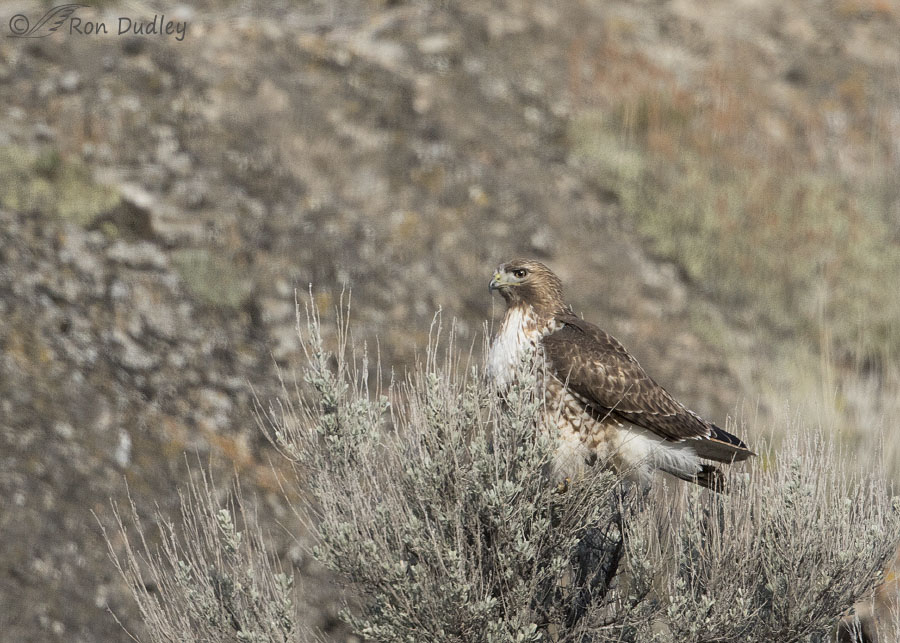
1/2500, f/5.6, ISO 800, Canon 7D Mark II, Canon EF 500mm f/4L IS II USM + EF 1.4 III Extender, not baited, set up or called in
This Red-tailed Hawk perched on sagebrush (notice that our sagebrush is finally beginning to green up a little) was my second decent raptor opportunity of the morning but that damned cloud did its very best to put the kibosh on me (at this point the cloud wasn’t thick so the light was filtered instead of the bird being in deep shade so I did have a chance at decent shots). Its presence meant that I had to use camera settings that were a little less than ideal to ensure I had enough shutter speed for flight shots and since I wasn’t particularly close to the bird I’d probably have to crop at least some of the photos enough that doing so might make digital noise even more noticeable.
That cloud presented a second problem. The side of a mountain was directly behind and very close to the hawk so if the bird took off the background would be very close to my subject. In poor light (or even mediocre light like this) contrast is usually low so camera sensors struggle to acquire and maintain sharp focus on the subject, especially when it’s moving and flying erratically. In that situation active focus points want to lock on to the background instead of the bird.
So without further ado let’s see how I did in these conditions when the bird eventually took off.
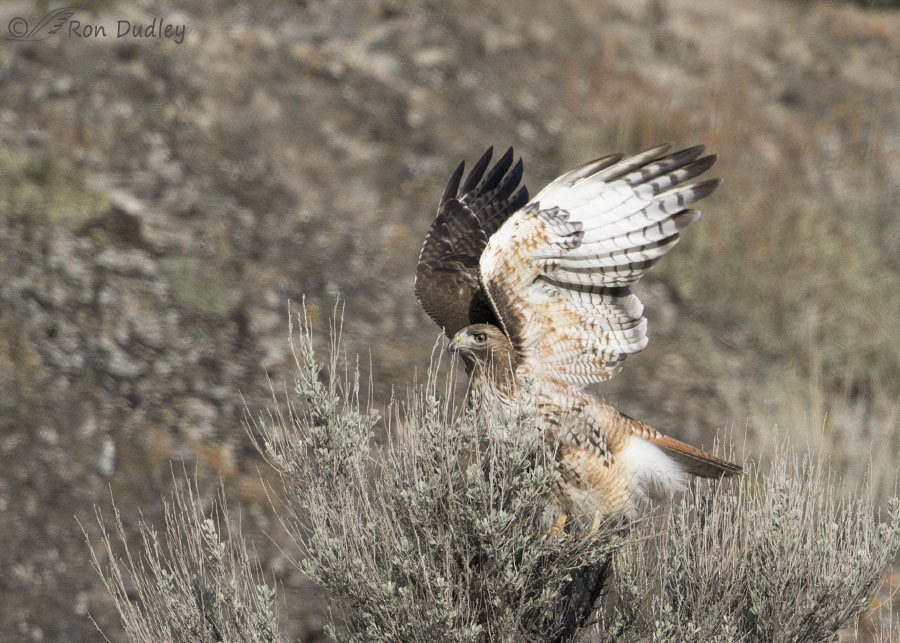
1/3200, f/5.6, ISO 800, Canon 7D Mark II, Canon EF 500mm f/4L IS II USM + EF 1.4 III Extender, not baited, set up or called in
The hawk had a lot of vertical sagebrush stems directly in front of it so its first task was to gain a foot or so of elevation in order to clear them. That slowed down its launch enough that…
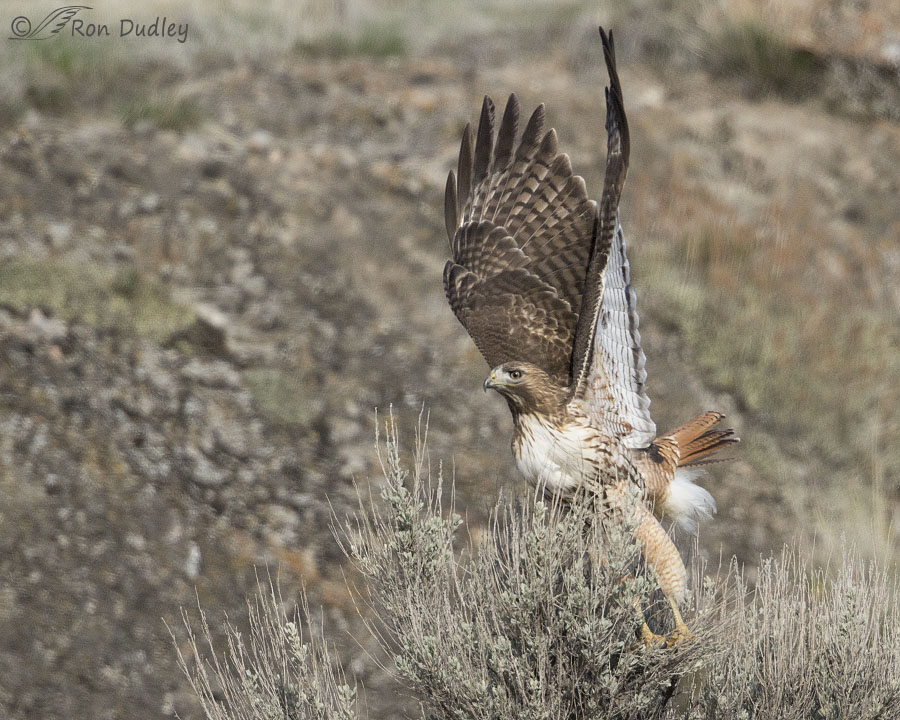
1/4000, f/5.6, ISO 800, Canon 7D Mark II, Canon EF 500mm f/4L IS II USM + EF 1.4 III Extender, not baited, set up or called in
I was able to get several photos before it completely left the sagebrush.
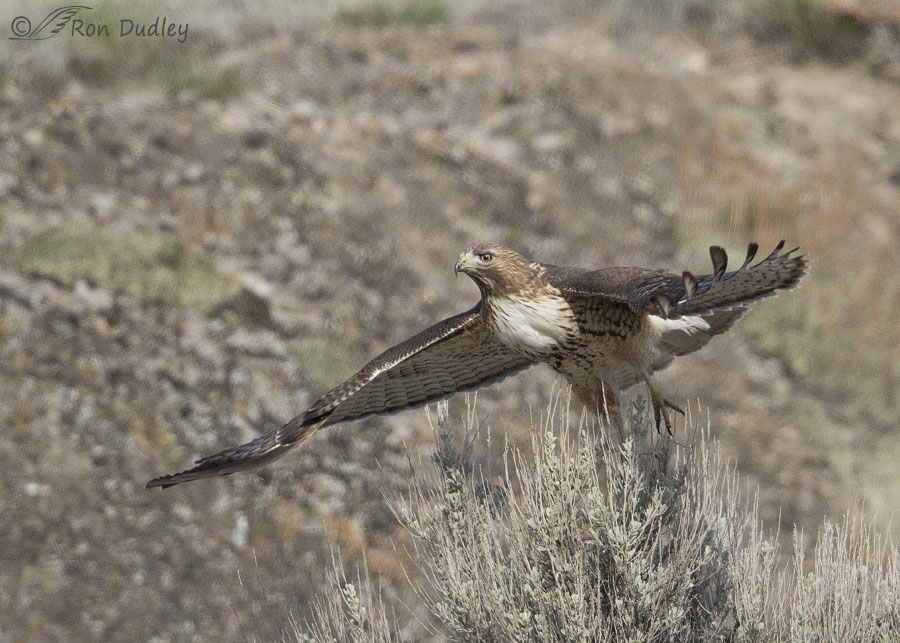
1/4000, f/5.6, ISO 800, Canon 7D Mark II, Canon EF 500mm f/4L IS II USM + EF 1.4 III Extender, not baited, set up or called in
At this point the light was changing very quickly, enough to throw some moderate shadows on much of the bird.
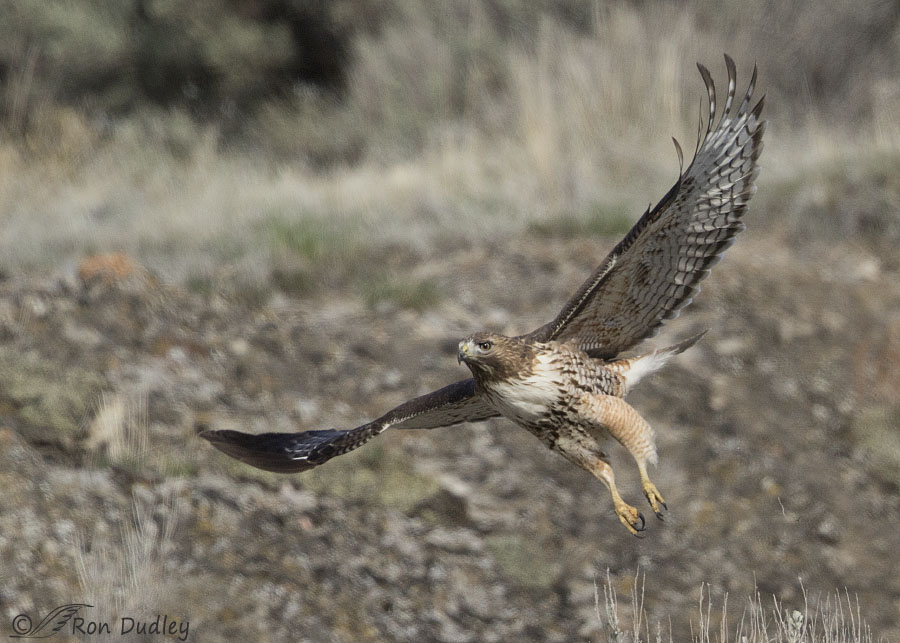
1/4000, f/5.6, ISO 800, Canon 7D Mark II, Canon EF 500mm f/4L IS II USM + EF 1.4 III Extender, not baited, set up or called in
But with the background so close to the hawk I struggled to keep sharp focus on the bird. Several of my photos were “sharp enough” but if you notice the file numbers of the images (by passing your cursor over the photos) I’ve left out a number of shots in the series because they were just too soft.
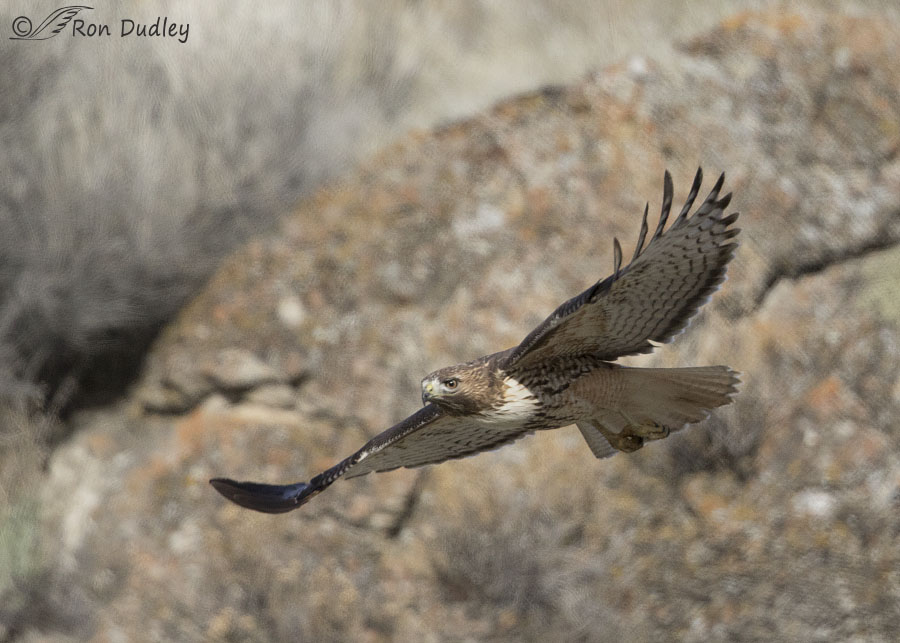
1/2500, f/5.6, ISO 800, Canon 7D Mark II, Canon EF 500mm f/4L IS II USM + EF 1.4 III Extender, not baited, set up or called in
The sharpest photos were those where the hawk’s wings were fully extended which gave my focus points more “bird” to lock onto with the background so close. In all of the images where the wings were curled around the bird during takeoff (which provided a smaller target) the photos were invariably softer. This one is borderline even though the wings are fully extended.
With birds and clouds we have no choice but to take what they give us and our results can be anywhere on a continuum between dreadful and surprisingly good. This time I think mine are acceptable but I sure won’t be entering any of these images in any photo contests (something I never do anyway…).
For me the biggest positive coming out of this series is that I added to my bird photography knowledge base and experience and that’s always a good thing.
Ron


I am fascinated by the white fluff under the tail in shot 3 with the vertical wings. Are those only the undertail coverts or are other feathers involved, too?
My eyes must not be fast enough to see that group of feathers when a red-tail takes off.
Pam, those undertail coverts are perhaps my favorite redtail hawk feathers. Their structure and fluffiness is just beautiful up close–so intricate and elegant. “Just beautiful” doesn’t even BEGIN to describe them. If it were legal, I’d send you one to ponder, but it’s not legal.
Ron, thanks for the tips about exposure and focus for birds in flight. These are great images– you are too hard on yourself. I generally keep my 80D in center point focus and assumed, perhaps erroneously, that if I got the bird in focus and kept the back-button pressed it would revert to servo mode and track the bird even if it strayed out of the center. I’ve blamed my bad shots on letting it get out of the frame. Need to go back to the product manual to check this out.
It should come as no surprise that adore redtails (that comes under the heading of DUH! LOL). Redtails, and raptors generally, take my breath away regularly, and this set of images makes me sigh with joy after each one. Just thank you! I’ve been doing gardening stuff, which wears me out, so I got to this late–again.
Ron,
To get flight and take-off shots do you use a single focal point or 9, 15, etc.?
Stephen
Stephen, See my response to Frank Sheets, below.
Fantastic shots Ron, absolutely beautiful, didn’t see the cloud (VBG)! Yes, I know how concerned you are, but to me I’d be most happy with anything half as good as these shots of yours.
Thanks, Dick. I’m reasonably happy with them given the conditions.
Colour me awed. And grateful.
These are truly delightful photos. Photos to return to, to pick out yet more details my inefficient brain missed first (and second) time through.
Megathanks.
Thank you, EC.
I think these are beautiful,,,,can’t even pick a favorite….
Thanks, Patty.
That third shot with the wings almost vertical and the leading edges curled under absolutely takes my breath away. Wow! Too beautiful for words. You mentioned being worried about “too many” Red Tails a couple days ago — if they’re all like this, I could look at them every day! 🙂
Thanks, Marty. There probably won’t me many more Red-tails posted for a while. The extended forecast looks dismal so I think for a while at least there’ll be more cabin fever in my future than Red-tails…
I keep thinking about Bruce Springsteen’s “Dancing in the Dark,” but adjusting it to “Photographing in the Dark.” 😉 Yes, I’m a total weirdo! Don’t climb the walls too much, Ron.
Love these images. Especially the wing e extended ones. Despite your issues with light etc I find the wing detail so interesting. Thanks.
Thank you, Gilly.
I enjoyed the light lesson. Pun intended. 😀
Thanks, Arwen. Pun appreciated…
Ron, agree 100% and what most attracted me to your site is your statement, “Not baited, set up, or called in.” A writer/photographer who put together a wildlife book for Arizona Highways said to photographers, “Be honest about how you got your photo.” Here in Prescott we have very strict laws about feeding wildlife, and the State of AZ is implementing new laws. You know for sure that some photographers bait mountain lions and other wildlife for photos. Your natural photos are as good as photos can get.
Everett
Everett, I’m sure that some folks get tired of seeing that “not baited, set up or called in” statement in my image techs, especially since I include it with every bird photo, even those that were obviously taken with no interference from me.
But I’ll continue to include it because baiting and setups in particular have become so very pervasive in “nature” photography and because photographers who do it have become so damned sneaky about it. With my photos I want there to be no question about it!
I appreciate your comment on that subject.
Yep, that was my experience in Kearny, Ne. photographing the sandhill cranes.The clouds were always over the sun in the morning and evening when the light is best. The rest of the sky was clear but that damn cloud fallowed the sun during the favorable light times. The other thing I noticed in Kearney is the clouds hang lower than in Utah, must be our mountains keep them higher. I was shooting at ISO 1600 and still got some wing blur, my lens is too grainy to shoot at a ISO any higher.
Sounds like you had some typical frustrations with those cranes at Kearney, April.
Hi Ron,
From my perspective any opportunity with a RedTail or any other raptor is a good opportunity even if the conditions aren’t optimal. A good educational post this AM, always appreciated. Just our of curiosity which of Canon’s AF modes to you prefer under these conditions.
Thanks again for your ongoing blogs. Look forward to it every morning.
Frank, I typically use single point AF for flight shots because it’s so precise and I use it exclusively when the background is close like this. Using multiple points active in that situation makes it easier for AF to grab onto the background.
I sometimes use 5 active points when the bird is in flight against a homogenous sky background.
Ron – The thing that I most appreciate about your flight pictures is the patience to wait for the bird to eventually take off and of course to be ready too. Songs birds no problem – it won’t be long, but for most raptors it can sometimes be a long wait, and then as we discussed before, for eagles, it can be forever. Patience is a virtue I have not been blessed with and it has often cost me. Just recently I took lots of still pictures of a Peregrine Falcon while waiting and waiting for it to take off. Finally gave up and sure enough as I was leaving I looked back and there it went. I’ll bet he or she was laughing while flying off knowing that it had beaten me. Always a joy to see your photos in the morning.
Everett Sanborn, Prescott AZ
Yes, waiting for raptor takeoff can certainly test one’s patience! I know of folks who deliberately flush them (including one well-known photographer who rants about ethics with raptors out of one side of his mouth but on the side flushes them on purpose to get the shot, at least he used to…).
Deliberately flushing large birds like raptors especially so we can get a flight shot wastes precious energy and it just isn’t right.
Yes, an “education” if nothing else……..;) Still good photo’s. The thing that has caught my attention with these is the detail of the eye – can REALLY see the detail of the color, shape and surrounding eye lids. 🙂 We’re doing more snow this morning……….. 🙁
Judy, Nearly always the eye is the focal point of a bird photograph so getting it sharp is very important. And having light in the eye is usually a huge positive.
Speaking of MT snow – from everything I’ve seen on FB it looks like the summer will be half over before they can get Going To The Sun Road in Glacier NP cleared of snow!
It does look that way! Some folks with a “reservation” for the Smith River got on it the other day and had ice issues requiring some help to get out of! They had the reservation so were going to go no matter what! They’ve closed a stretch of the river for now!
Don’t you just LOVE everything about raptors! You caught my favorite wing shots…especially the start of the launch…that straight-up pose always moves me! Like the background colors with this bird also. Great photos of a great bird!
Thanks, Kathy. Yes, I DO love everything about raptors…